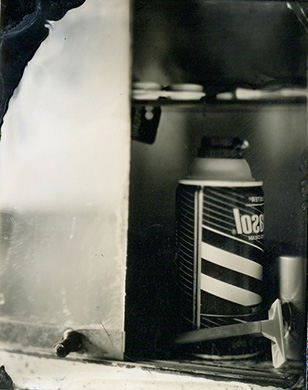


The mummies are encased in glass, with indirect light. They range in age from less than zero (there are a few fetuses) to between forty and fifty. They include a Peruvian child mummified in 4500 BC, a middle-aged Egyptian embalmed during the Roman occupation of Egypt and a Baron interred during the Thirty Years War. There are forty-five mummies in all, along with animal mummies and displays of knives, jars and other paraphernalia.
The exhibit, Mummies of the World, is drawn from the collections of research institutions such as the Reiss-Engelhorn Museums in Germany, the Museum der Kulturen in Switzerland, and the Hungarian Natural History Museum in Hungary. Its sponsors-- American Exhibitions, Inc.—also produced the enormously successful Our Body: The Universe Within, which displayed plastinated cadavers to demonstrate the inner workings of the body. In response to the criticism that exhibit received from ethicists, a sign reminds visitors that the mummies “were once living people with families and friends,” who “lived their lives differently than we do today,” yet nonetheless “must be treated with dignity and respect”. The interactive videos explaining DNA tests, radiocarbon dating and other investigative procedures also point out that “invasive” procedures are used only as a last resort (as mummification itself usually involved sucking out the brain through the nasal cavity, one imagines the mummies would have appreciated such fastidiousness).
As I wandered through the dark cavernous rooms of the exhibit, accompanied by an audio guide with a British-accented voice uncannily resembling James Mason’s, the marvels of mummification were slowly revealed to me. I was fascinated to learn that South American Indians had perfected mummification techniques thousands of years before King Tut. That European pharmacies used to sell ground-up mummy remains as medicine. And that in 1994, the American Egyptologist Robert Brier, a specialist in paleopathology, used a donated human cadaver to create a modern mummy by following instructions preserved in ancient Egyptian texts.
Most of the mummies are bony and dessicated, almost papery; others sculpted and smooth. Still others are tar-like or leathery. In an oddly reassuring way, decay has made it impossible for the casual viewer to determine the mummies’ ethnicity or race. When one’s remains look like dried beef jerky or the steak bone the dog has gnawed too many times, skin pigmentation hardly matters.
Three of the mummies are particularly worth noting. The first is of a middle-aged Egyptian with an enormous erection. The audio guide explains that the penis was moulded by embalmers, to guarantee the deceased pleasure in the afterlife. The second is the aforementioned Peruvian child, known as the Detmoid Child, displayed in a sitting, slightly fetal position— a round head with a pug nose and heavy eyelids, poised above a tiny body, hands tucked neatly between the knees. The lower limbs are clearly defined— Even the toes are discernable. And finally the Tatooed Woman, Chilean, late 20s, face turned up, matted black hair, a striped shawl partially covering her back and shoulders, and, most intriguingly, the same tattoo -a dot inside an oval-on each breast and below the left corner of her mouth. What the tattoos signify is unknown.
To its credit, the exhibit makes no mention of Hollywood depiction of mummies, though I couldn’t help but think of Boris Karloff’s 1932 classic horror film, The Mummy. In the film, Karloff plays a mummified Egyptian priest named Imhotep accidentally brought back to life by a British archeologist reciting an ancient oath found on a sacred scroll. Karloff, we discover, was buried alive 3,700 years prior for trying to resurrect his girlfriend. Realizing he has a second chance, he tricks archeologists into finding and exhibiting his girlfriend’s remains so he can resurrect her. It soon becomes apparent though that her soul has migrated into the living body of a beautiful young British socialite played by Zita Johann. The film’s climax occurs when the archeologists catch Karloff trying to mummify Johann so he can bring her back to life. They burn the sacred scroll and Karloff turns to dust.
The film was made shortly after the discovery of King Tut’s tomb and sarcophagus. Although Hollywood was undoubtedly mistaken in giving mummies a bad name, the film does address the inseparability of love and death—and suggests that unsatisfied desire can lead to destruction. Mummification thus becomes a metaphor – we want the impossible (to defeat death) and by so doing, underscore our mortality. Just as Karloff cannot die, but is doomed to pursue his lover throughout eternity, so our own wish not to die becomes sublimated into the loving rituals with which we preserve our dead. But immortality, and forgetting, are both impossible. Perhaps the fear we have of mummies is that they point to the paradox that, just as we know we must one day part from those we love, so we can never truly part with them either. Only in the grave will our union either be complete or our separation total.
I couldn’t help but feel sad that this kind of insight was missing from the exhibit—that for all its political correctness and scientific objectivity, the exhibition missed something deep and profound. In its effort to make the uncanny accessible, it turned reverence into etiquette, and awe into curiosity. While I was grateful that, as a result of this exhibition, tens of thousands –perhaps hundreds of thousands—would know more about mummies, the spiritual dimension of mummification was lost. While the exhibition’s displays made a big to-do about unlocking mysteries, it didn’t address the deepest one—the continuity between these ancients and ourselves. After the last set of relatively recent European mummies –including the Baron from the Thirty Years’ War, whose never-before-worn-over-the-top leather boots are now back in fashion—I reached an area just before the exit. I was greeted by a series of brightly lit signs displaying pictures of some of the mummies you have just seen:
MUMMIES ARE PEOPLE
EACH HAS A STORY TO TELL ABOUT A PLACE,
AND A MOMENT IN HUMAN HISTORY
WHO WAS THIS PERSON?
HE LIVED IN NORTHEAST ASIA
HIS PELVIS WAS DISLOCATED
WE DON’T KNOW WHEN HE DIED
HE WAS MORE THAN SEVENTEEN WHEN HE DIED
WHO WAS SHE?
SHE LIVED IN CHILE BEFORE A.D. 1460
HER PEOPLE CONSIDERED HER SKULL DEFORMATION BEAUTIFUL
SHE HAS UNUSUAL TATTOOS
WHEN DID HE OR SHE LIVE?
SHE OR HE LIVED MORE THAN
MOST EGYPTIAN MUMMIES
HAVE NO BRAIN LEFT IN THEIR SKULL
THIS MUMMY DOES
WE DO NOT KNOW IF THIS WAS THE HEAD OF A MAN OR A WOMAN
I was half-expecting the last display would be a mirror with the caption: WHO WAS HE? HE LIVED IN THE EARLY 21ST CENTURY. HE ATE HAMBURGERS AND LIKED VIDEO GAMES. I lingered for awhile at the comment book, but was at a loss as to what to say. Many people wrote that they enjoyed the exhibition. But to me, “enjoy” didn’t seem quite the right word. You enjoy a hamburger. You enjoy listening to Beethoven. But do you enjoy looking at human remains? In the men’s room, I looked at myself in the mirror. I touched my face with my fingers-- my eye sockets, my cheekbones, my chin. I thought of how much I loved my body—the pleasure I had in being able to blink my eyes, open my mouth, extend my fingers. When it was gone, would I miss it? But how could I miss it if I, too, would be gone? Was my body me? Or was it simply a chrysalis that I would someday leave behind as I metamorphosed into something else? It the end of the hallway was a small sign on a stand: THERE IS NO REENTRY ONCE YOU LEAVE…

